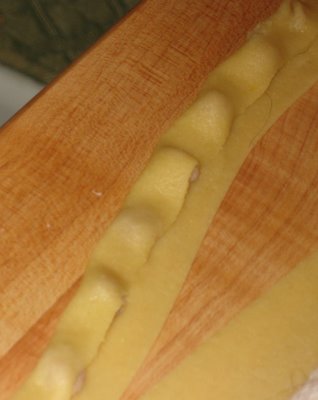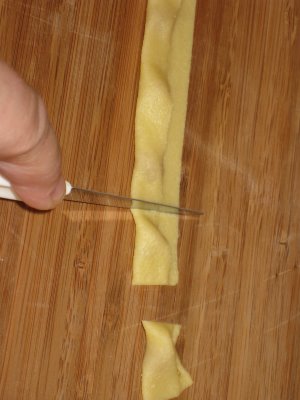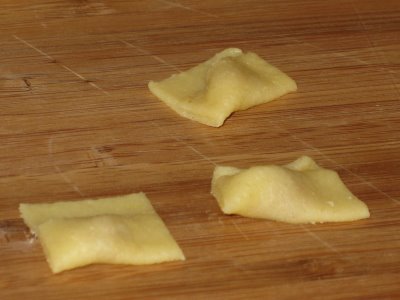Filling and Twisting the Tortellini

After you have rolled your pasta through a “hand cranked” pasta machine (we use the Atlas brand) several times to your desired thickness (at least at the very minimum on #4 thickness), you then lay the delicate pasta down on a wooden surface (I recommend that you have on hand several different sizes of wooden cutting boards, very slightly floured to help prevent sticking).


Begin to layout small little balls of the filling (about the size of a large pea or small bean) along the edge of the exposed pasta dough (don’t worry if your dough is not perfectly straight).


Roll the edge of the dough over the filling balls so that they are completely covered with dough.

Once you’ve overlapped all of the filling balls, take your finger and just press down lightly between each of the filling balls to show where you need to cut each tortellini from each other.
Then take a small sharp knife and cut about 1/4″ from the edge of the balls (see above) to slice each section from the rest of the uncut dough.

With your sharp knife, cut each section of filling off the strip.

Then you’re going to have these nice little UNFOLDED tortellini . . . notice that on the top side of the tortellini there is that 1/4″ of extra dough sticking out.

Picking up one at a time, flip the 1/4″ of extra dough over to seal in the filling, just as if you are closing an envelope flap. Wrap it around your finger and then press the edges to seal it into that beautiful “hat or cap” shape. I use my LITTLE ‘pinky’ finger, because my family prefers our tortellini to be smaller sized (they expand when cooked).



COUNT how many you have made. This is easy to do if your lines, both vertically and horizontally, are perfectly in line and then you just simply multiply the two outside vertical and horizontal lines. Papa then takes a piece of paper and writes down how many tortellini are on each board. Then you just set them aside in a safe place (we have cats and dogs!) and cover them with a towel if you need extra protection from the pets! You can either drop them in the brodo (broth) immediately, or allow them to dry overnight.

Like I said, watch your animal companions . . . here is our trusty Buckeye (W.D. is from Ohio!)
who was just waiting for a treat for Papa to drop a tortellini !!!
(R.I.P. dear Buckeye, my precious boy at 12 years young, who passed of canine epilepsy, January, 2015)
The entire family (which includes our pets) gets involved with the process!

Finally, either fresh or dried, gently place the delicate tortellini in the delicious chicken brodo that you made and boil them until they rise to the top . . . taste the tortellini to determine that the pasta is cooked “al dente”, not soft! Also add some salt to the brodo to your preference level, it really enhances the flavor quite a bit . . . it’s totally up to you.
Serve with FRESHLY GRATED PARMIGIANO cheese!
Buon Appetito!



Hello Truth 4 the Journey! And welcome to my foodie blog. Enjoy all of those prescious years that you have with your 5 daughters. It is so much fun to teach children to cook. They have so much fun!
Nice to meet you too! I’ll continue to stop by your blog!
Roz
This looks and sounds wonderful! I think you are so blessed that you have Papa to help you (and your cute dog!). I would love to teach my daughter (I have 5) how to make homemade pasta. I do make homemade bread (we even grind our own wheat) but pasta hasn’t been something I’ve tackled yet.
Nice to meet you!
Sonya